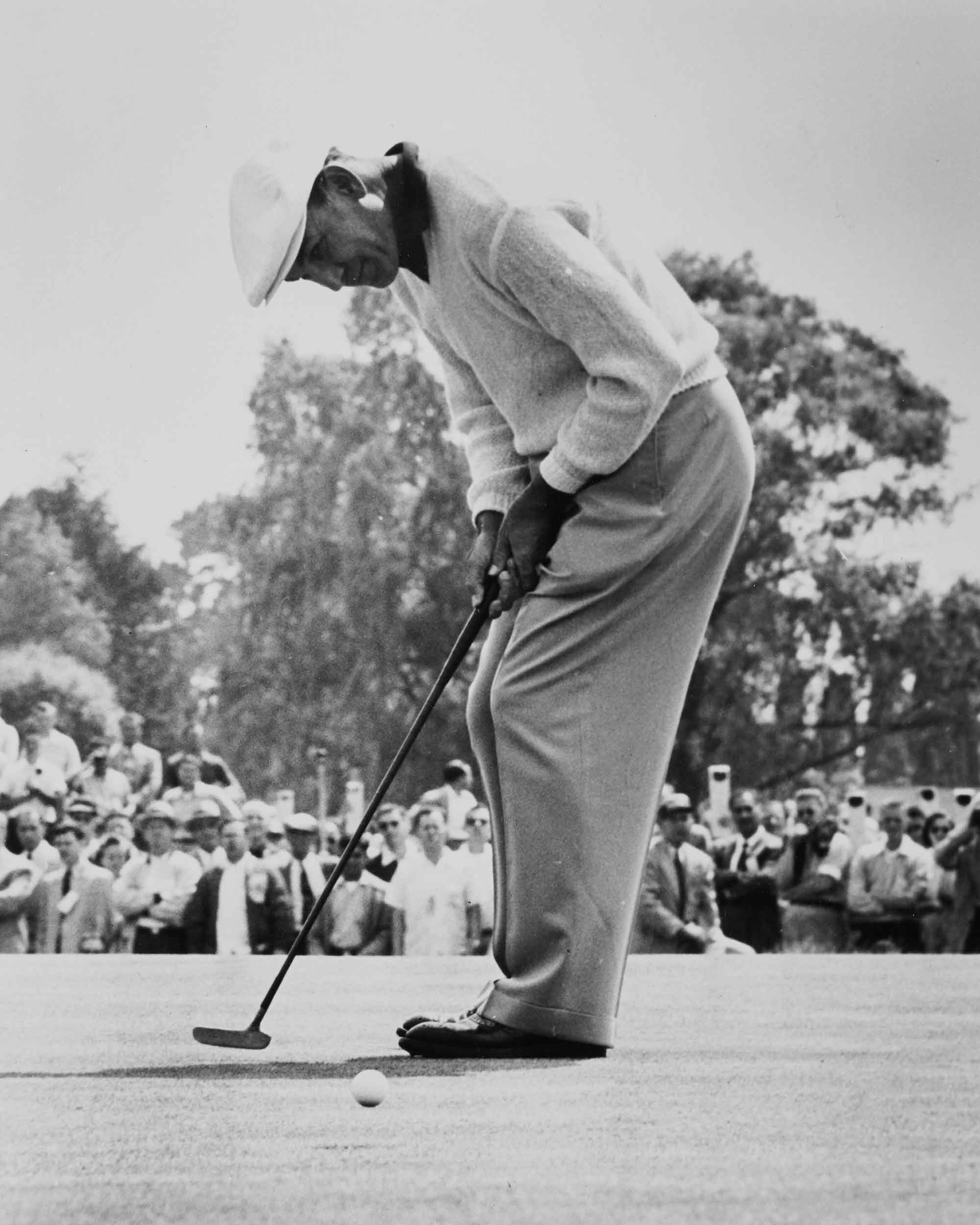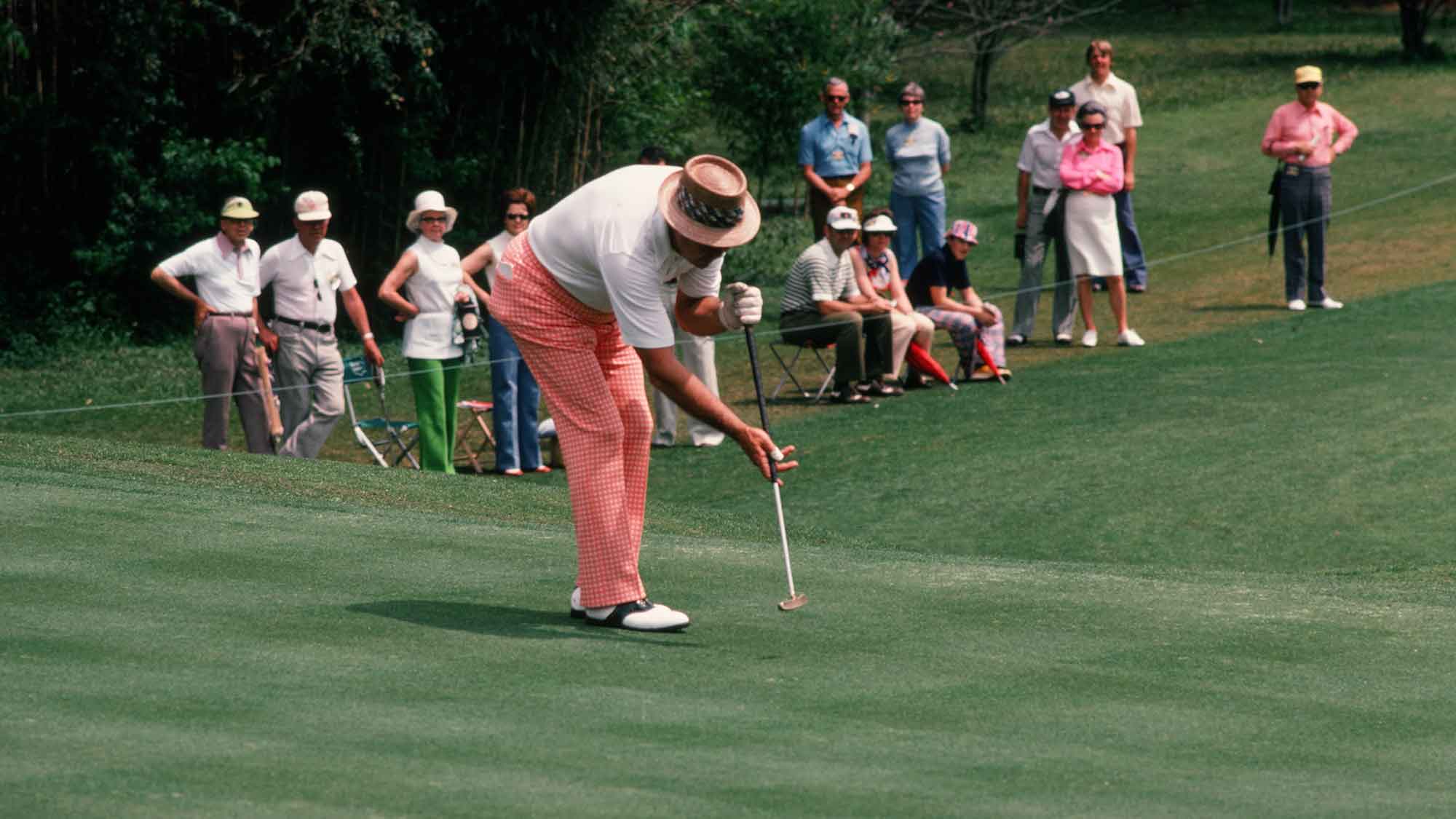If You’ve Had ’Em, You’ve Got ’Em.
This is a continuation of our special series commemorating the 50th anniversary of Australian Golf Digest, showcasing the best literature we’ve ever published. Each entry includes an introduction that celebrates the author or puts in context the story.
I acquired a taste for Henry Longhurst because all my British friends thought he was the best, and they were right. “He pioneered golf commentating on radio and television and set a standard which no one has remotely approached since,” said Peter Dobereiner of Pratts Bottom.
“His international reputation as a story-teller, reporter, essayist was nothing short of brilliant,” said Renton Laidlaw of Sunningdale.
“Longhurst was in a class by himself,” said Herbert Warren Wind, who was decidedly not British but believed himself to be.
My most British friend was the BBC’s correspondent in America, Alistair Cooke, who adored Henry. Alistair looked to him not for tour-pro insight, but for practical tips on how to play the game. Longhurst could write features and instruction, so he had a perspective that set him apart as a golf sage. Henry always gave it to you straight. “Longhurst said you mustn’t blow your nose when your partner was addressing the ball, but otherwise the book of rules was mostly nonsense,” Cooke explained. “As for the heroes of golf, he inclined to the scamps and the droll ones.” Cooke liked to say, “There was no one like Henry.”
Longhurst had a storied career. He played for Cambridge University; won the German Amateur in 1936 and was runner-up in the French Amateur in 1937; was elected to Parliament as a Conservative in 1943 and lost his seat two years later; joined the BBC as a senior golf correspondent and eventually worked for CBS and ABC in America at the same time. As a journalist, he wrote for The Times of London and for Golf Digest in the US. Whether in broadcast or in print, he was known for his economy of words. He said things like: “Golfing excellence goes hand in hand with alcohol, as many an open or amateur champion has shown.” In this piece, published in September 1973, he describes, and prescribes for, one of golf’s eternal mysteries. – Jerry Tarde

There can be no more ludicrous sight than that of a grown man, a captain of industry perhaps and a pillar of his local community, convulsively jerking a piece of ironmongery to and fro in his efforts to hole a three-foot putt.
Sometimes it is even a great golfer in the twilight of his career, in which case the sight is worthy not of ridicule but of compassion. He will battle on for a year or two, but twilight it is, for “once you’ve had ’em, you’ve got ’em”. I refer, of course, to what Tommy Armour was the first to christen the “Yips”.
When he wrote a book called The ABC of Golf, Armour had no difficulty with the letter Y. The Yips drove him out of tournament golf. On a somewhat humbler level, they drove me out of golf, too, and a long and agonising process it was, ending on D-Day, 1968, the anniversary of the invasion of Europe. On that occasion, I put my 25-year-old clubs up into the loft with the water tanks, where they remain to this day because I am too mean to give them away.
Armour wrote graphically of “that ghastly time when, with the first movement of the putter, the golfer blacks out, loses sight of the ball and hasn’t the remotest idea of what to do with the putter or, occasionally, that he is holding a putter at all”.
This confirms the description of that most distinguished of all sufferers, Bob Jones, who recorded that just before the moment of impact the ball “seemed to disappear from sight.” Jones also recorded how he once was partnered with that sterling character of the late 1920s and early ’30s, Wild Bill Mehlhorn. Poor Mehlhorn! He was only three feet from the hole, said Jones, but gave such a convulsive twitch at the ball that it shot across the green into a bunker. He then had the humiliation of exchanging his putter for his niblick, and, we may assume without being unkind, that was the last seriously competitive round he ever played.
Contemporary with Jones and Mehlhorn was Leo Diegel, whose extraordinary spread-elbowed putting style put a new phase into the golfing vocabulary – “to Diegel”. I watched him on the 18th green at St Andrews in 1933 when, from some yards above the hole, he had two to tie for the British Open title. While his partner holed out, Diegel paced up and down, much as an animal in its cage, repeatedly taking off his felt hat and mopping his brow. When his turn came, he charged the ball down the slope, several feet too far, chased after it, and, almost before it had come to rest, yipped it a foot wide of the hole. Everyone knew, as I am sure he did, too, that Diegel would never win an Open now.
Armour wrote, “Yips don’t seize the victim during a practice round. It is a tournament disease.” Here the great man was certainly wrong. My mind goes back to a conversation at Augusta with Craig Wood, who was robbed of the 1935 Masters by Gene Sarazen’s historic double-eagle. Craig told me that he even got the Yips on the practice green, all by himself and with nothing at stake. Again, Armour says, “I have a hunch that the Yips is a result of years of competitive strain, a sort of punch-nuttiness with the putter.” Wrong again, surely, for you will see any number of compulsive yippers, though many may not admit it, in Sunday foursomes whose members never play serious competitive golf at all.
In winning the 1931 British Open, Armour, having perpetrated a most frightful Yip to miss from two feet on the 71st hole, found himself faced with a three-footer to win. “I took a new grip, holding the club as tightly as I could and with stiff wrists, and took a different stance… From the instant the club left the ball on the backswing, I was blind and unconscious.”
Next day that greatest of golf writers, Bernard Darwin, recorded in the London Times that he had never before seen a man so nonchalantly hole a three-foot putt to gain a championship!
Who, would you guess, wrote the following, in what book?
“As I stood addressing the ball, I would watch for my right hand to jump. At the end of two seconds, I would not be looking at the ball at all. My gaze would have become riveted on my right hand. I simply could not resist the desire to see what it was going to do. Directly, as I felt that it was about to jump, I would snatch at the ball in a desperate effort to play the shot before the involuntary movement could take effect. Up would go my head and body with a start, and off would go the ball, anywhere but on the proper line.”
That was written by Harry Vardon, winner of six British Opens and one US Open, indisputably the greatest golfer that the world has yet seen. And the book was titled How to Play Golf!
Americans sometimes refer to the Yips rather unkindly as “whisky fingers”, and sometimes no doubt they are. Perhaps the last word on “whisky fingers” – and almost my favourite golfing quotation – was uttered by Vardon to a lady who was trying to persuade him to sign the pledge. “Moderation is essential in all things, madam,” said Vardon gravely, “but never in my life have I been beaten by a teetotaller.”
Sam Snead, whose fluent style has lasted longer than any other man’s in the history of the game, was reduced to putting between his legs, croquet fashion – and he was a total abstainer for years. The croquet putter gave many a golfer, myself included, an extended lease on life, and the banning of it was an act of cruelty to many hundreds of miserable wretches for whom the very sight of a normal putter set their fingers twitching. The ease with which you could line up one of these croquet putters to the hole was quite remarkable. By holding the club at the top with the left hand, thumb on top of the shaft, and loosely lower down with the right arm stiffly extended, the most inveterate yipper could make some sort of stroke at a four-foot putt which would not expose him to public ridicule.

We did not ask to hole it; all we wanted was to be able to make a stroke at it, and this we could do. The United States Golf Association not only decided to ban a method which had brought peace to so many tortured souls but the group let its decision become public before the Royal & Ancient Golf Club of St Andrews had time to consider it, thus putting the latter in the impossible position of either banning the club or falling out with the USGA. So they banned the club.
Further proof that the dreaded disease is not traceable to a dissolute way of life was furnished by the “Iron Man” of golf himself, Ben Hogan, who of all the men who have played golf since the game began would have seemed most likely to be immune. The rot set in, so eyewitnesses have assured me, on the 71st green at Rochester in 1956, when he was well placed to win a record fifth US Open. Not only did he miss the three-footer, which anyone could do, but he yipped it, and that was the beginning of the end. At any rate, my last memory of Hogan in competitive golf is at the Masters some years ago. Every green, as usual, is surrounded with spectators and, as the familiar white-capped figure steps through the ropes, everyone spontaneously rises to give him a standing ovation. And a moment later he is stuck motionless over the ball, as though hypnotised, unable to move the ironmongery to and fro.
Is there any cure for this grotesque ailment? Few people can have made a more penetrating research than myself. The first led me to a psychiatrist-cum-hypnotist, who solemnly tried through my inner self to talk the ball into the hole. This, of course, was ridiculous since all I was seeking was that, on surveying a four-foot putt, a massive calm should automatically come over me instead of the impression that I was about to try to hit the ball with a live eel.
Better hope came from an Austrian doctor, who wrote to say that he knew the solution and would be willing to reveal it to me. Within a matter of hours I was visiting him in his rooms in London. “It all comms,” he said, “from ze angle of ze right ell-bow.” Something in that, I thought, recalling how, with the right arm stiffly extended, one could at least make some sort of stroke with the croquet putter. The theory seemed to be supported by the fact that, if you have difficulty in raising a glass to the lips, it is when the arm bends to approximately the putting angle that your drink is most likely to make its bid for freedom.
What he said next, however, blissfully unaware of the full horror of his words, was, “Violinists very often get it.” We may imagine a silent audience of 6,000 people in, say, London’s Albert Hall, and the maestro in the spotlight, his right arm fully extended, drawing the bow delicately across, when suddenly, the elbow having arrived at the putting angle… A-a-a-ah! He nearly saws the instrument in half, and his career is ended. I once told this ghastly little story to Ben Hogan during a World Cup match and thought his eyes began to turn glassy. Only later did I suspect why.
Innumerable “cures” for the Yips have been tried and passed on from one sufferer to another. Looking at the hole instead of the ball; putting left-handed; putting cross-handed with the left hand below the right, and putting with the hands wide apart (probably the best bet of the lot). A friend of mine has had his hands about a foot apart, with the left below the right, and then pulls down as hard as he can with the right – and he a one-time runner-up in the British Amateur.
As an ancient and finally defeated warrior – three putts from a yard on the 18th at St Andrews, and only as few as three because the third hit the back of the hole, jumped up, and fell in – I listen politely to all their tales. But the bitter, inescapable truth remains. Once you’ve had ’em, you’ve got ’em.




